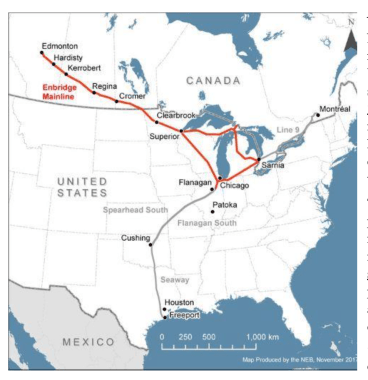
Ignoring How Militarism Fuels Climate Change Will Be the Death of Us (Repost)
By Sue Ann Martinson ScheerPost July 14, 2022
Editor’s Note: Sections of this article originally appeared in the Summer 2022 issue of the Women Against Military Madness newsletter.
The U.S. Department of Defense (DOD) has over 800 bases and over 4,775 defense sites in the world. DOD owns 8.8 million acres in the U.S. alone with at least one base in each state. (1)
For decades the U.S. military has contaminated the air, soil, and water worldwide, including in the United States, by burning or burying contaminants on land or dumping them in the ocean and then hiding or simply not reporting major pollution. Aside from fossil fuels, some of the toxins the Pentagon is spreading are: bacteria, pathogens, metals such as lead and mercury, and per-and polyfluoroalkyl (PFAS) substances in foams used in firefighting.
Killing for Oil
Actively polluting the environment isn’t the only way our military is killing the planet. As the progressive think tank Institute for Policy Studies points out in the section on Killing for Oil in their primer about militarism, fueling climate change, the United States has a well-known history of fighting bloody wars for oil.
“An estimated one-quarter to one-half of all interstate wars since 1973 have been linked to oil. The U.S. military spends an estimated $81 billion a year to protect the world’s oil supplies. The fossil fuel industry relies on militarized state violence to uphold its operations around the globe. The activists who fight to protect their lands and infrastructures from industries that extract their resources are often branded as ‘eco-terrorists’ and met with violence from state or paramilitary forces. Indigenous peoples disproportionately subject to this violence make up about 5% of the world’s population yet they are about a quarter of those murdered for defending land and the environment.”
A recent example is the cold-blooded murders of British journalist Dom Phillips and Indigenous affairs expert Bruno Pereira in Brazil on June 9, 2022. Worldwide and in the U.S. their lands, their cultures, their way of life, and their lives are threatened. And as the IPS points so succinctly points out, with climate change we all may experience increased ilitary response such as people of color have already experienced.
“In the United States, militarized local police departments have acquired surplus military equipment from federal agencies. With a bloated military budget that leaves climate change action underfunded, we face increasingly militarized responses to the climate crisis nationwide and also worldwide.”
No Reporting = No Accountability
Some examples of polluted areas are:
Marinara Islands: In 2016, after Pacific war games near the Marinara Islands, “the military left behind tons of toxic waste — dumped into the ocean — including heavy metals, motor gasoline and chemicals harmful to humans and marine life.” This dumping practice by the U.S. military has been going on there for decades.
Pacifica, Asian Islands, Palau, Marshall Islands Micronesia: The colonial legacy and neo-colonization does exist. Compacts of Free Association are treaties with the United States that subject people to practices from the Department of Defense and armed forces: pollution and failure to report emissions.
Red Hill Naval Base, Hawaii: As I reported previously on ScheerPost,
“on November 28, 2021 approximately 19,000 gallons of jet fuel and water leaked from underground fuel storage tanks at Red Hill [Navy Base] and contaminated two wells providing drinking water for over 93,000 persons… The tank complex sits only 100 feet above Honolulu’s main aquifer. Many persons … went to emergency rooms with rashes, vomiting and diarrhea.”
In addition, the U.S. military dumped 630,000 toxic nitrate compounds (chemicals used in waste-water treatment and explosives) into the water in 2019. They had federal permits to do so.
Okinawa, Japan: Extensive water contamination comes from chemicals contained in firefighting foams (PFAS) used on military bases. Oil contamination comes from shuttling of fuel near Defense Department facilities on Okinawa, farmers’ fields and rivers that are polluted and have contaminated the drinking water sources of 450,000 residents. On Okinawa there is no official push for accountability, and active citizen groups in Okinawa are met with many barriers created by the U.S. military.
As Col. Ann Wright (Ret.) reports for Popular Resistance:
“The US military’s Indo-Pacific command headquartered in Honolulu, Hawai’i, Rim of the Pacific or RIMPAC 2022, military war games, will have 38 ships from 26 countries, 4 submarines, 170 aircraft and 25,000 military personnel practicing naval war maneuvers in the Hawaiian waters from June 29-August 4, 2022. Additionally, ground units from 9 countries will come ashore on the islands of Hawai’i in amphibious landings.
The Pacific Peace Network, with members from countries/islands across the Pacific,…demand that RIMPAC be cancelled, calling the naval armada “’dangerous, provocative and destructive.’
… The Hawaii-based Women’s Voices, Women Speak [has] declared that ‘RIMPAC causes ecological devastation, colonial violence and gun worship. RIMPAC’s ship sinking, missile testing, and torpedo blasting have destroyed island ecosystems and disturbed sea creatures’ wellbeing. This convening of military personnel promotes toxic masculinity; sex trafficking and violence against local populations.”
These U.S. military war games are practiced often in different parts of the world, leaving a trail of pollution from their dumping at the end of the “games” as well as causing harm to the ocean’s ecosystem and creatures. Although the U.S. is the main offender, other countries partake in similarly damaging exercises. The International Army Games, initiated by the Russian Defense Ministry, is a competition that is sometimes called the War Olympics. This year they will be held in August with Venezuela as the host; 37 countries are registered. Similar disruption to ecosystems as in U.S. military war exercises occurs in these “let’s pretend war is a game” maneuvers as well.
Note that most of the bases previously mentioned are not U.S. bases in Europe where this sort of contamination would impact largely white populations. Much of the pollution that is not reported takes place in the Pacific area. All bases worldwide have some pollution with burn pits and PFAS for firefighting and CO2 from jet fuel. But these Pacific bases are on Indigenous lands where the Indigenous populations are treated shabbily, to say the least, by the U.S., with long histories of colonization that continues to this day in new forms.

Native American communities and reservations are treated similarly in the U.S., for example uranium mining in the southwest and pipeline projects like Standing Rock, which was shut down after massive protests, and Enbridge’s Line 3 that has pipelines that send fossil fuel down the continent to the Gulf of Mexico and east to the international port of Montreal.
This latest form of neo-colonization takes place in Africa as well where the U.S. military protects the interests of multinational corporations that virtually steal the resources of African countries. The people who live in these areas are already among the most affected by the climate crisis and have the most yet to lose.
Some other examples of military contamination include:
United States: “The DOD suspects or acknowledges contamination by military munitions of an estimated 15 million acres of U.S land. Cost of cleanup is estimated from $8 to $35 billion.” Many of these are Superfund sites require ongoing cleanup. A number of these properties are now Formerly Used Defense sites (FUDS), and the lands originally used for manufacture of munitions have been transferred to other Federal or Non-Federal uses.
A Minnesota example is:
“The New Brighton/Arden Hills/TCAAP superfund site [which] consists of the Twin Cities Army Ammunition Plant (TCAAP) and parts of surrounding communities affected by contaminants from the plant. Waste dumped at 14 locations within TCAAP between 1941 and 1981 led to soil, sediment and groundwater contamination. The site’s total area… is about 25 square miles.”
Site cleanup and monitoring are ongoing. An extensive water filtering system has been constructed to purify the water and soil contamination addressed.
PFAS as foam used especially in firefighting was found in toxic levels in the water at Minnesota’s Camp Ripley and at most other military bases in the U.S. and worldwide.
Depleted Uranium (DU) is “a radioactive by-product of uranium enrichment … used to coat ammunition such as tank shells and ‘bunker busting’ missiles because its density makes it ideal for piercing [armor].” DU was used extensively in wars in Iraq and was found to contaminate the water and soil and cause birth defects. It is also thought by some to be a cause of Gulf War Syndrome, affecting many Iraq veterans.
Burn Pits are “the most common means of toxic exposure; they have been used extensively since 1990 to protect privacy and leave as little footprint behind as possible. Service members use jet fuel to burn waste including chemicals, paint, medical and human waste, metal/aluminum cans, munitions and other unexploded ordnance, petroleum and lubricant products, plastics, rubber, wood, and discarded food.”
Agent Orange is an herbicide and defoliant used extensively during the Vietnam War to remove the tree leaves and tropical foliage, affecting thousands of Vietnamese and veterans. Exposure can cause multiple cancers and other serious health problems. It is now affecting the grandchildren of those exposed. While the evidence is before their eyes, the U.S. government has refused to acknowledge the effects of Agent Orange on the children and grandchildren of the Vietnamese people and veterans, possibly because of the costs involved. Action continues to hold them accountable through legislation.
Other contaminants include Radiation Exposure and Embedded Fragments.
The Eco-Cost of the Ukraine War: As in any war, military activities involve solvents, fuels, methane, uranium, and other toxic chemicals that leach into the soil and water and air. Heavy military equipment causes further damage to agricultural soils and infrastructures such as community roads and bridges. Bombs and drone strikes add to the pollution of land and air as well.
As Chris Hedges writes in a piece for ScheerPost:
“The proposed budget for the Environmental Protection Agency (EPA) is $11.881 billion. Ukraine alone gets more than double that amount. Pandemics and the climate emergency are afterthoughts. War is all that matters. This is a recipe for collective suicide.”
Nuclear Weapons Manufacture and Testing:
“The production of nuclear weapons has polluted vast amounts of soil and water at hundreds of nuclear weapons facilities all over the world. Many substances released, including plutonium, uranium, strontium, cesium, benzene, polychlorinated biphenyls (PCBs), mercury and cyanide, are carcinogenic and/or mutagenic and remain hazardous for thousands or hundreds of thousands years. Contaminants from nuclear weapons production and testing have often traveled far downwind and downstream. Radioactivity released from atmospheric nuclear testing has dispersed widely throughout the world; underground tests have contaminated soil and groundwater. A 1991 U.S. government report called the soil contamination from underground testing at the Nevada Test Site ‘a threat to human health and the environment.’”
COP Conferences, the Paris Agreement, and Net Zero
In order to understand the role of the military it is necessary to look at the background of the United Nations COP conferences attended by nations worldwide and industrialists every year.
What is COP? COP stands for Conference of the Parties. “In diplomatic [language] ‘the parties’ refers to the 197 nations that agreed to a new environmental pact, the United Nations Framework Convention on Climate Change, at a meeting in 1992.” These are the meetings where representatives from the nations of the world and the industrialists make decisions. The 26th COP meeting was held in November 2021.
What is Net Zero? “To ’go net zero’ is to reduce greenhouse gas emissions and/or to ensure that any ongoing emissions are balanced by removals” from the atmosphere so global warming stops. COP21 in 2015 is best known for the Paris Agreement, which asked countries to go net zero to achieve this balance and also asked wealthy countries to give money to developing countries to help them reach net zero goals. When Donald Trump was chosen as president he delayed participation and finally turned his back on the whole Agreement.
The military is the elephant in the room at all COP gatherings. For example, at COP26, independent reporter Abby Martin of The Empire Files confronted Nancy Pelosi for overseeing massive budget increases for the Pentagon—a greater polluter than 140 countries combined—while touting “historic” leadership on climate change and skirting around the issue of U.S. imperialism, stating clearly that “security” (military control) was most important, all the disastrous effects of the climate crisis being nothing but a big etcetera.
Mia Mottley, Prime Minister of Barbados, at the Opening Ceremony of COP26, November 1, 2021 sounded an alarm:
“CODE RED. Code Red to the G7 countries. Code Red to the G20. Earth to COP — that’s what it said. Earth to COP. For those who have eyes to see, for those who have ears to listen, and for those who have a heart to feel, 1.5 is what we need to survive; 2 degrees, … is a death sentence for the people [of the Global South.] We’ve come here today to say ‘try harder’ because [we] need our actions now, not next year, not in the next decade.”
In her speech she identified several areas that need to be heeded: nationalism, technology, and financing solutions to the climate crisis. She pointed out that these areas are dependent on technology that has not yet been developed, especially in the case of net zero, which is the inadequate plan of the industrialists that the U.S and other nations have signed onto, and is not the same as zero emissions, which means no emissions at all.
How can we trust technology even if it is successfully developed for net zero? How can we trust the Big Oil companies who, with inflated prices, collectively made $93.3 billion in the first quarter of 2022.
Let’s ask the families of those who died in the Deepwater Horizon oil spill in the Gulf of Mexico in 2010 about how reliable technology is. Net zero is dependent on technology that has not yet been developed. To achieve what they call “the balance” with net zero is expensive, not guaranteed to be effective, and allows the Big Polluters their profits. It is a slow solution at best when a slow solution will not save the planet.
Military Omissions and Emissions

“There’s enough wind and sun on the earth to power the whole earth with solar panels and windmills, and we just need a little bit better storage and ways to transmit it. So we don’t need them to help, we need them to get out of the way and stop emitting CO2.”
There’s a Pentagon-sized hole in President Biden’s plans to cut government CO2, carbon, and greenhouse gas emissions. Biden signed an executive order in January 2022 directing the government to reach 100 percent carbon-free electricity by 2030 and net-zero emissions by 2050 in line with COP26 goals. It also calls for eliminating climate pollution from federal buildings and vehicles. As E&E News reports:
“But the executive order exempts anything related to national security, intelligence, or military combat and training.
That means Biden’s order covers only a fraction of federal emissions. While military leaders insist they share the president’s decarbonization goal there is no plan for them to meet it.”
The military has actually done very little to decrease CO2 emissions and other pollutants, greenwashing their actions to end climate change.
“Since 2001, the military has accounted for 77 to 80 percent of federal energy use, according to the Costs of War 2019 study released by Brown University’s Watson Institute for International and Public Affairs.”
“We are up against two massive power centers though, the fossil fuel industry and the military-industrial complex.
In the April 2022 webinar “The Ecology of War,” Prof. Neta Crawford, co-director of the Costs of War project at Brown University’s Watson Institute and Prof. Alan Robock, co-director of the Rutgers Impact Studies of Climate Intervention (RISC) lab, discuss the role of the military in the climate crisis.
Crawford says most technological innovations the military produce are only useful for military purposes: “I wouldn’t want the military leading us to the green transition that we need. Commercial, that is civilian technology, would be much better suited to making a rapid transition.”
Prof. Robock elaborates:
“There’s enough wind and sun on the earth to power the whole earth with solar panels and windmills, and we just need a little bit better storage and ways to transmit it. So we don’t need them to help, we need them to get out of the way and stop emitting CO2.”
Neta Crawford goes on to say that “the climate crisis will kill people: it already is.” The solution to global warming is to leave the fossil fuels in the ground and switch as quickly as we can to renewable sources:
“We are up against two massive power centers though, the fossil fuel industry and the military-industrial complex. They make lots of money and have armies of lobbyists going to Congress telling them other things and giving them money so that they can run for re-election. It’s very frustrating fighting against that, but that’s what we’re up against.”
Addressing the climate crisis requires holding the military-industrial-congressional complex accountable and dismantling that complex, as well as holding President Biden accountable for exempting the military from cutting federal emissions.
Michael T. Klare, a founder of the Committee for a Sane U.S.-China Policy whose latest book is “All Hell Breaking Loose: The Pentagon’s Perspective on Climate Change,” offers a bleak view in TomDispatch of what will happen if we follow the warfare state instead of choosing to save the planet—a track the leaders of state are now pursuing instead of cooperating around the climate crisis. While Biden frames perpetual war as being about freedom and democracy, others see it as raw imperialism—as U.S. corporate wars of hegemony and empire—and continued oppression by the ruling elites to maintain their own power and profits at great expense to the poorer countries on earth in the Global South.
The recent decision by the Supreme Court in West Virginia v. EPA narrowed the powers the Environmental Protection Agency has to regulate carbon emissions under the Clean Air Act. As NPR reports,
“By a vote of 6 to 3, the court said that any time an agency does something big and new—in this case addressing climate change—the regulation is presumptively invalid, unless Congress has specifically authorized regulating in this sphere.”
This decision has plainly given the fossil fuel industry more freedom to pollute and also is directly out of line with COP26 goals for 2030 and 2050 regarding curtailing carbon emissions, even as those goals are inadequate.
Above all, U.S. corporations continue to drag their feet as they have for decades now by not addressing climate change until it has snowballed into an existential climate crisis.
Another barrier is that prominent environmental groups and individuals often do not make the connections between militarism and the climate crisis. Early on in their activism, many thought they could sway corporate weapons manufacturers and the war industry as well as gas and oil corporations and thus did not wish to alienate them—a practice some still basically follow. However, numerous antiwar groups nationwide including Women Against Military Madness (WAMM) and Veterans for Peace, have stepped forward to educate and to resist and transform how militarism fuels the climate crisis.
The young people who will inherit this planet are stepping into organizing and resistance, and solidarity is growing across the planet. These are all signs of hope.
***
Sue Ann Martinson is a member of WAMM’s End Military Madness Against the Earth action group and an associate member of Veterans for Peace, Chapter 27. She edits and publishes an online alternative news and news analysis source, Rise Up Times: Media for Justice and Peace (riseuptimes.org).
1. Federal Land Ownership Overview and Data. Congressional Research Service, 21 Feb. 2020.
Some examples of military pollution and effects on climate change in this article are from the “War is Not Green” brochure created by the Women Against Military Madness EMMAE action group.





